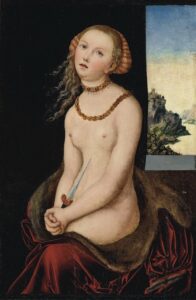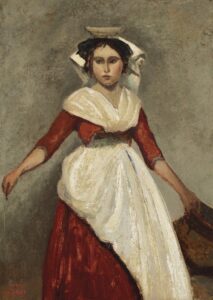
Lucas Cranach I (Kronach 1472-1553 Weimar) Lucretia
signed with the artist’s winged-serpent device,
oil on panel, transferred to board. Courtesy Christie’s NY.
Twelve artworks from the Brooklyn Museum are going to auction at Christie’s in October 2020 in the first highly publicized de-accessioning taking place under an Association of Art Museum Directors’ (AAMD) Covid-19 moratorium. The best-known work is Lucas Cranach the Elder’s “Lucretia”, the only work by that artist in the museum’s collection and the most valuable of the group, estimated to sell for $1.2m to $1.8m. Other early works include paintings by Donato de’ Bardi, Giovanni dal Ponte, and Francesco Botticini. These will be offered for sale at Christie’s old masters live auction on October 15. An online European art sale starting on the same day will include works by Gustave Courbet, Camille Corot, Hendrik Willem Mesdag, Charles-François Daubigny and Philip Wilson Steer.
The Association of Art Museum Directors passed several resolutions in April 2020, stating that because of the hardships created by the pandemic, it would refrain for a limited time period – up to April 10, 2022 – from censuring or sanctioning any museum, or suspending or expelling any museum director that used restricted endowment funds, trusts, or donations for general operating expenses. The AAMD also allowed a specific use for funds generated from the sale of objects in museums’ collections – to pay for expenses associated with the direct care of collections.
Under its standard rules of good practices for museums, the AAMD ordinarily bans the selling of artworks for any purpose other than to accession other artworks. Under these strict rules, the AAMD can censure, suspend, or expel a member, or censure or sanction an art museum that violates AAMD standards, whether or not the director of the museum is a member of the AAMD. In years past, the AAMD has come down hard on violators.

Jean Baptiste Camille Corot (French, 1796-1875) Italienne debout tenant une cruche, oil on canvas on panel. Courtesy Christie’s, NY
If a museum is sanctioned, the AAMD asks its 243 member museums to suspend any loans of works of art or collaborations on exhibitions with that museum. Regardless of whether or not a sale is legal according to the museum’s founding documents, it can be held to have violated accepted museum best practices. For example, in May 2018, the AAMD placed formal sanctions on the Berkshire Museum and the La Salle University Art Museum when they used proceeds from the sale of artwork for operating budgets and expansions.
The goal of the Brooklyn Museum’s auction sales is to create a $40 million fund that will raise $2 million per year in income. The funds will be used exclusively to cover the costs of care of the collection, including conservation, cleaning, or moving an artwork –the types of expenses envisioned under the AAMD moratorium. The funds will not be used to cover utilities, exhibitions or public programs.
The sale of the Brooklyn Museum artworks fits within the parameters of the AAMD moratorium. Christine Anagnos, AAMD executive director, told the NY Times that the Brooklyn Museum’s approach would both address the museum’s immediate need for funds for care and build a system for long term care of the collection. The AAMD appears prescient in anticipating, in early April, the scale of the financial pressures on museums that would result from the pandemic. Museums across the United States, Canada, and Mexico – the AAMD’s primary purview – have been forced to close and when a few have reopened, their costs for maintenance have substantially increased and revenue from tourism has declined precipitously.

Gustave Courbet (French, 1819-1877)
Bords de la Loue avec rochers à gauche
signed and dated ‘G Courbet./68’, oil on canvas, Courtesy Christie’s NY.
Anne Pasternak, the Brooklyn Museum’s director, said that while it was a hard thing to do, it was in the best interests of the institution. “We have a deep collection of high-quality art, but we have works that — like many museums of our size — have not been shown ever or for decades.” She noted that in terms of a museum’s core mission, having the funds to care for the entire collection could be viewed as more essential than retaining works that, like those being offered for sale, have rarely or never been but on view, given the enormous size of the museum’s collection and its limited exhibition space.
Some in the art world vehemently disagree: critic Robert Storr told the Times, “This is the last resort, and it is a very, very bad move to be making. What we’re witnessing is an institutional and social betrayal of lasting impact and we need to put the brakes on.”
Josh Knerly on the two-year change in restrictions on use of funds from de-accessioned art

Donato de’ Bardi (Active in Lombardy and Liguria 1426–1450/51)
Saint Jerome
tempera, oil and gold on panel, Courtesy Christie’s NY.
Soon after the AAMD announcement, Stephen J. Knerly[i], an attorney for the AAMD, made a telephonic presentation for the public at the American Bar Association, sponsored by the Art & Cultural Heritage Law Committee,[ii] to explore the new rules and their application.
In providing background for how the standard ethical rules regarding de-accessioning came to be, Knerly noted that principal collections are not viewed as financial assets to museums. Most art museums don’t carry collection items on the balance sheet and separately account for funds received from the sale of de-accessioned works as temporarily restricted to art purchases. The Financial Accounting Standards Board adopted a rule in the 1990s that allowed this if the museum had a policy that requires the proceeds from the sale of an artwork in the collection to be used to acquire other artworks for the collection.
Knerly said that the AAMD has made it clear that the pandemic has created extraordinary challenges for museums that justifies special action. By taking this step, the AAMD gives museums a temporary but powerful argument for their position on de-accessioning with donors and attorneys general representing the public interest in museums.
He said that if the art museum followed the processes described by the AAMD, and used the relevant funds for general operations, the AAMD would not censure, suspend, or expel a member, or censure or sanction an art museum.
Museums must:
- make a determination that the funds are needed to maintain operations and staffing and
- act in good faith, and if practicable consult with the donors or trustees.
- The decision to use the funds has to be made by the director and the board, and
- the museum must document how it uses the funds.

Francesco Botticini (Florence 1446-1498)
Saints Anne and Joachim
tempera and gold on panel, unframed, a fragment, Courtesy Christie’s NY.
Under these special circumstances, and for the 24-month moratorium period, museums could use for general operations:
- Income from endowments or trusts restricted to purposes other than general operations, including those restricted for art purchases.
- Income from the proceeds of the dispossession of de-accessioned works of art, whether the works were de-accessioned before or after the AAMD action. (He notes that this only applies to the income from the funds received from dispossession of de-accessioned artworks, not the principal.)
- Restricted donations or trusts not restricted to income, but not available for general operations, i.e. endowment funds expendable for an exhibition could be repurposed for general operations.
Although the AAMD states it will not take action against a director or a museum if the above rules are followed, museums could need to obtain donor or court approval.
Knerly was asked after the presentation whether there were concerns with de-accessioning in that museums might be encouraged to sell too many items in their collection. Was there a sense that with the commercial art market at a standstill, there might not be any buyers?
He replied that one of the benefits of this resolution is not with respect to sales but rather for the ability to use funds already on hand from works already de-accessioned. “The combination of being able to use those funds for direct care and also being able to use those funds for general operations are immediate benefits.”
Knerly pointed out that auction houses have pivoted very quickly to online sales and according to their press statements, these are going pretty well, and that the private market continues. He said that museum directors are pretty conservative and the idea that they are going to just dump objects onto the market at a time when the market is in a state of flux is not likely.

Attributed to Lorenzo Costa (Ferrara 1460-1535 Mantua)
Portrait of a gentleman, bust length, signed with the letter ‘C’, tempera and oil on panel, transferred to board, Courtesy Christie’s NY.
Knerly was asked about defining ‘direct care,’ whether it included the salaries of individuals that care for collections like registrars, curatorial, etc. or if it is limited in scope to what the individual museums define on their own terms.
He responded that each museum has to come up with its own definition but that museums could look at the American Alliance of Museums White Paper, Direct Care of Collections, Ethics Guidelines and Recommendations[iii]for guidance. He said that one of the reasons the definition needs to be public is because it needs to undergo the scrutiny of public opinion, have merit, and hold water – the AAMD purposely hasn’t taken a position on what constitutes direct care. One could also look at other museums and their collection management policies.
Asked what might happen if a museum used 100% of the proceeds, not just the income from the proceeds for operating costs: would the museum be sanctioned? Knerly pointed out that what the AAMD has said is that a museum can use the proceeds for direct care, not for general operation. If a museum decides to go beyond that, then the AAMD will have to decide what action it wants to take. The AAMD will not be precluded from taking action by virtue of the resolution.
Finally, Knerly was asked about the possible risk that museums will want this type of policy in the future during economic difficulty. He responded that there is always a risk when you create an exception, at some point the exception will swallow the rule. But, he said, that is why the AAMD has been very clear that the pandemic is an unprecedented, worldwide event that is unlikely to occur in the same way or the same manner again. It really shouldn’t be used as a precedent for a museum that gets into financial trouble or during another economic downturn.
It appears that the AAMD’s temporary moratorium – particularly with respect to large institutions for whom the majority of their donated collections are held in reserve, and never see the light – could in the end benefit both museums and the art market. The temporary policy change gives museums a much needed cushion against the financial pressures of COVID and at the same time, it frees objects for private enjoyment and the likely donation to another institution in the future.
[i] Stephen J. Knerly is a Partner at Hahn Loeser & Parks LLP, 200 Public Square Suite 2800, Cincinnati, OH.
[ii] Tele-Coffee with Josh Knerly to explore the recent Association of Art Museum Directors (AAMD) Board of Trustees determination to relax temporarily the AAMD’s restrictions on the use of various art museum funds as result of the Pandemic Crisis, American Bar Association, International Law Section, presented by the Art and Cultural Heritage Law Steering Committee, April 30, 2020.
[iii] American Alliance of Museums – Direct Care of Collections: Ethics, Guidelines, and Recommendations, March 2019 update.
 Lucas Cranach I (Kronach 1472-1553 Weimar), Lucretia (detail), signed with the artist’s winged-serpent device (lower right)
oil on panel, transferred to board. Courtesy Christie's NY.
Lucas Cranach I (Kronach 1472-1553 Weimar), Lucretia (detail), signed with the artist’s winged-serpent device (lower right)
oil on panel, transferred to board. Courtesy Christie's NY. 

